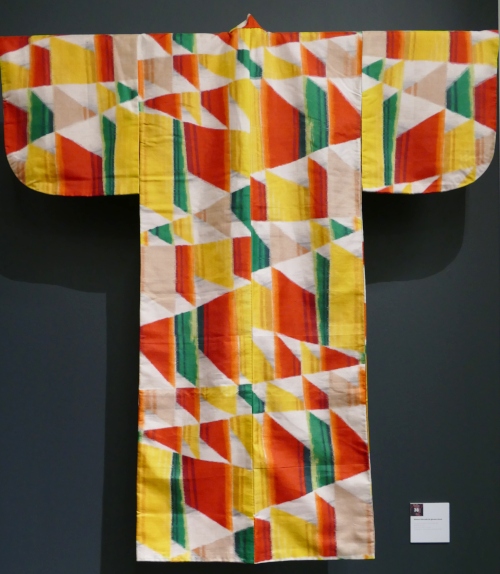Last I week I talked about an exhibition about Roberto Capucci's dresses, in the same museum there was another very interesting exhibition called "Occidentalism. Modernity and occidental art in kimonos from the Manavello collection 1900-1950".
.
La scorsa settimana vi ho parlato della mostra con gli abiti di Roberto Capucci, nello stesso museo c'era un'altra mostra molto interessante: "Occidentalismo. Modernità ed arte occidentale nei kimono della collezione Manavello 1900-1950). Qui il link alla mostra, mentre sotto ci sono le foto che ho scattato, il resto del testo è in inglese (è semplicemente la traduzione della presentazione sul sito che potete trovare al link indicato sopra).
Translated from the museum website
[...] An exhibition dedicated entirely to kimonos. Not ordinary ones, but those made in Japan between 1900 and the 1940s, pieces that reflect the imperial will to occidentalize the country.
So as in the previous century, Japonism flared up everywhere in Europe, influencing a significant part of the artistic production, at the beginning of 1900 the occidental taste breaks out in Japan. And this wave of novelty invests even that garment which is a symbol of tradition: the kimono. Alongside the traditional patterns we now see colourful designs that recall promptly Cubism, Futurism and other European artistic trends. There is even a particular kimono that celebrates the 1940 tripartite pact Rome-Berlin-Tokyo, where the Italian flag is half hidden on the inside of the seams while the Rising Sun and the swastika is everywhere.
So much has been said and written about Orientalism and in particular about Japonism, which is the influence of Japanese arts over the European ones between the end of 1800s till the beginning of 1900s, but we still we do not know so much about the reverse connection, which is that complex and faceted phenomenon that brought some Japanese arts to absorb forms and contents of occidental origin.
It happened with paintings, that interpreted prospective originally, and happened with kimonos that, more than any form of art, were influenced by the changing of the Japanese society of the time, transferring accurately the effects on fabrics, used as a painting surface.[...]
This period is one of the most complicated and troubled in Japanese history: the passage from feudal state to superpower, culminated with the second World War.
From a sociocultural point, the Rising Sun Land lived this time lapse (end 1800s-1940s) with a conflictual attitude, on the borderline between the thrill of novelty coming from overseas and the reassuring attachment to tradition.
In the occidental imaginary collective, kimonos represent the icon itself of Japan in its persuasive elegance and exoticism. But only a few know that a good part of kimonos made in the first half of 1900s, the Meisen kimonos, are not part of this category, implementing patterns hinted by movements like Avant-garde (from Viennese Secession to Glasgow School, from Futurism to Cubism, from Divisionism to Jackson Pollock's abstract Expressionism), inspired by contemporary historic facts or by technological progress, in an exciting and surprising kaleidoscope of colours, patterns, decoration techniques and weaving, inspired from occidental textile production as well. [...]
Garments are sophisticated, meant for middle-upper class, not tailored for export. They could be enjoyed by people of culture or curious or wilful of being at the pace of time. They had for sure their vision: their country at the same level to other important countries, able to absorb their knowledge and their costumes but with their own pride about their own diversity. [...]
This period is one of the most complicated and troubled in Japanese history: the passage from feudal state to superpower, culminated with the second World War.
From a sociocultural point, the Rising Sun Land lived this time lapse (end 1800s-1940s) with a conflictual attitude, on the borderline between the thrill of novelty coming from overseas and the reassuring attachment to tradition.
In the occidental imaginary collective, kimonos represent the icon itself of Japan in its persuasive elegance and exoticism. But only a few know that a good part of kimonos made in the first half of 1900s, the Meisen kimonos, are not part of this category, implementing patterns hinted by movements like Avant-garde (from Viennese Secession to Glasgow School, from Futurism to Cubism, from Divisionism to Jackson Pollock's abstract Expressionism), inspired by contemporary historic facts or by technological progress, in an exciting and surprising kaleidoscope of colours, patterns, decoration techniques and weaving, inspired from occidental textile production as well. [...]
Garments are sophisticated, meant for middle-upper class, not tailored for export. They could be enjoyed by people of culture or curious or wilful of being at the pace of time. They had for sure their vision: their country at the same level to other important countries, able to absorb their knowledge and their costumes but with their own pride about their own diversity. [...]







No comments:
Post a Comment